Kitesurfing in Sri Lanka: A Comprehensive Exploration
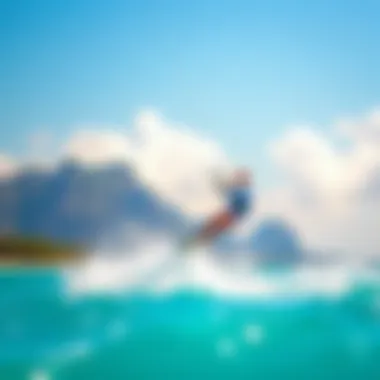
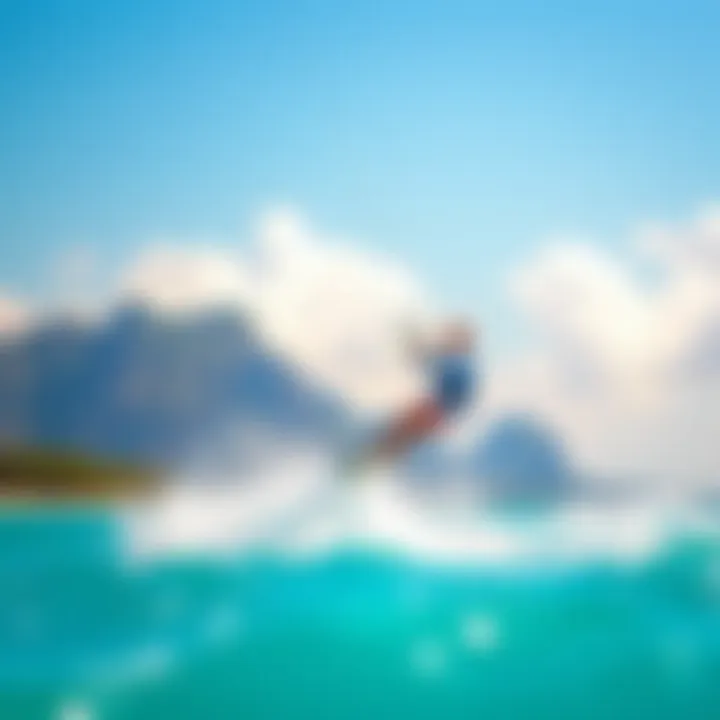
Intro
Kitesurfing has taken the world by storm over the last couple of decades, and Sri Lanka stands out as a prime destination for enthusiasts from all corners of the globe. The island's unique blend of stunning landscapes, favorable wind conditions, and vibrant local culture creates a haven for both seasoned pros and those just dipping their toes into the sport. As you begin to unravel the art of flying across the waves, you'll quickly realize that kitesurfing here isn't merely about the thrills; it extends into a lifestyle deeply rooted in Sri Lankan tradition and community.
The thrill of catching a wave while harnessed to a kite creates an experience that goes beyond physical exertion. Here, kitesurfing melds with the tranquil backdrop of palm trees against azure waters, giving thrill-seekers a canvas of pure joy. However, the nuances extend well beyond mere enjoyment. This article weaves a complete tapestry of the kitesurfing scene in Sri Lanka, offering insights that will engage both hardcore enthusiasts and curious newcomers.
With some of the best spots situated along the coasts of Kalpitiya and Mirissa, the island welcomes kitesurfers throughout the year, making it a melting pot of cultural exchange and sport. As you delve deeper into this exploration, you'll encounter essential techniques, lifestyle aspects tied to surfing, and sustainable practices vital in preserving the beauty of Sri Lanka's beaches. Unique experiences await you, guiding you through the waves of this thriving marine paradise.
"Sri Lanka’s kitesurfing culture is a reflection of its warm hospitality and respect for the ocean, nurturing a community that thrives on shared experiences."
You are about to embark on a journey that covers everything you need to know to enjoy kitesurfing in this idyllic setting. From the fundamental techniques that every beginner should master to advanced tricks that will leave onlookers impressed, understanding the lifestyle and cultural significance of kitesurfing here is the key to enriching your experience. So, grab your gear, and let's set sail on this exploration of kitesurfing in Sri Lanka.
Preamble to Kitesurfing
Kitesurfing stands out as an exhilarating water sport that combines elements of surfing, windsurfing, and paragliding. As an engaging way to ride the waves, this sport has gained momentum across the globe, becoming a favorite for thrill-seekers and those drawn to the vast expanse of the open water. In Sri Lanka, kitesurfing has carved out a special niche, captivating both local surfers and tourists alike. Understanding this sport is crucial, as it reveals not just the mechanics of how it works but also the culture and community that surround it.
Understanding the Sport
At its core, kitesurfing involves harnessing the power of the wind with a controllable kite while riding a board on the water's surface. This simple definition, however, does little justice to the intricacies of the sport. The learning curve, while steep, is what makes it particularly rewarding. Beginners often start with basic training to grasp essential techniques such as launching, landing, and maintaining control. As one progresses, the thrill shifts from simply hanging on to the board to incorporating exciting tricks such as jumps and spins. This evolution is not just physical; it’s a mental journey that demands focus and confidence. When practicing kitesurfing, one learns to read the water and wind, making quick decisions that can greatly affect the experience.
Kitesurfing cultivates a sense of freedom. Riders often describe it as soaring, dancing with the elements, connecting the person to nature in a way few other sports do. In regions like Sri Lanka, where the ocean meets varied wind conditions, the diversity in kitesurfing experiences can keep both newcomers and seasoned surfers intrigued.
Kitesurfing Terminology
To engage in kitesurfing successfully, one must familiarize themselves with both the jargon associated with the sport and the various components that play a pivotal role in kitesurfing. Here are some essential terms:
- Kite: The inflatable structure that catches the wind and propels the rider.
- Board: The platform on which the kitesurfer stands; different shapes and sizes exist for different styles and skills.
- Harness: The equipment worn around the waist or seat that connects the rider to the kite, allowing for easier steering.
- Lines: The ropes connected to the kite, which enable the rider to control its movement.
- Wind Window: The area in which the kite can fly, characterized by the direction and strength of the wind.
These terms represent only a fraction of the lingo that kitesurfers often use, but understanding them can greatly enhance one’s engagement with the sport. This foundational knowledge allows newbies to interact more confidently within the kitesurfing community, which is invariably welcoming and eager to share tips and insights.
"Kitesurfing is not just a sport; it's a language that speaks of freedom and adventure."
Embracing this terminology isn't just about learning how to communicate—it also adds depth to the experience, fostering connections between enthusiasts of all levels.
In essence, kitesurfing encapsulates a range of skills and a rich lexicon that paves the way for enthusiasts to delve deeper into its practices. Whether you aim to catch your first wave in Sri Lanka or are an experienced rider looking for the perfect location, grasping the fundamentals is the first step to a fulfilling experience.
Sri Lanka as a Kitesurfing Destination
Kitesurfing in Sri Lanka is taking the world of adventure sports by storm, and for good reason. This beautiful island nation offers not just picturesque landscapes but also optimal conditions that attract kitesurfers from across the globe. With its diverse geographical features and consistent winds, Sri Lanka is becoming a cherished haven for both beginners and seasoned riders alike. The following sections will delve into the unique characteristics that make Sri Lanka a top-tier destination for kitesurfing.
Geographic Overview
Sri Lanka is often dubbed the Pearl of the Indian Ocean, and its geography plays a pivotal role in shaping its kitesurfing profile. The country is surrounded by pristine beaches that have a wide variety of spots, each with its own unique attributes. From the long stretches of the Kalpitiya Peninsula to the sheltered bays of Unawatuna, there is something for everyone.
- Kalpitiya: Known for its steady winds and flat waters, Kalpitiya often hosts international kitesurfing competitions. It’s also a draw for dolphins and other marine life, making it a picturesque spot.
- Unawatuna: This location not only offers decent kitesurfing conditions but also a vibrant nightlife and local culture, appealing to those looking for both adventure and leisure.
- Mannar: Often lesser-known, Mannar boasts strong winds and a more authentic local vibe, providing a contrast to the more commercial kitesurfing destinations. The stretch of beach here allows for long runs, making it ideal for more advanced maneuvers.
The diversity in kitesurfing spots means that each session can be a different experience, yet consistently thrilling.
Climate and Wind Patterns
For kitesurfing, wind is the lifeblood, and Sri Lanka is blessed with wind patterns that favor the sport. The best times to kitesurf generally fall between November and April. During these months, the northeast monsoon brings reliable winds reaching speeds of 15-25 knots; ideal for both beginners and advanced kitesurfers.
- Wind Consistency: The prevailing winds are predominantly side-onshore, which benefits kitesurfers by allowing smooth take-offs and landings while maintaining a safe distance from the coastline.
- Temperature: The air temperature in Sri Lanka is warm year-round, averaging around 27 to 30 degrees Celsius, which, combined with the wind, creates a comfortable environment for kitesurfing.
The confluence of these factors means kitesurfers can expect consistent conditions that enhance their skills and provide an exhilarating experience.
"Kitesurfing in Sri Lanka is not just another activity; it’s almost a rite of passage for thrill-seekers. The perfect wind, the warm waters, and a community that recognizes this sport’s energy create an atmosphere like no other."
In summary, Sri Lanka stands out as a premier location for kitesurfing due to its diverse geography and favorable climate conditions. As more people discover these elements, the island continues to solidify its status as a must-visit for kitesurfers around the world.
Popular Kitesurfing Locations in Sri Lanka
Kitesurfing in Sri Lanka isn’t just a pastime; it’s a way of life for many locals and visitors alike. The island's diverse coastline offers a handful of prime locations that cater to all skill levels. Understanding where to kite surf can significantly enhance your experience, making it essential to explore the popular spots. Each local has its unique features, challenges, and advantages, proving why they are favorites among enthusiasts. From breathtaking views to friendly local vibes, the right spot can make a world of difference in your kitesurfing adventure.
Kalpitiya
Spot features
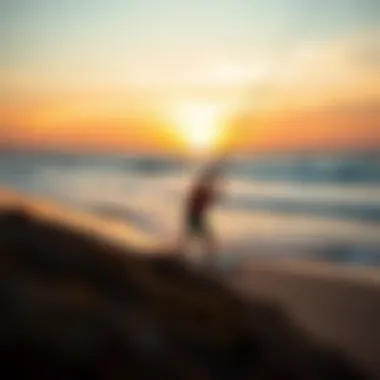
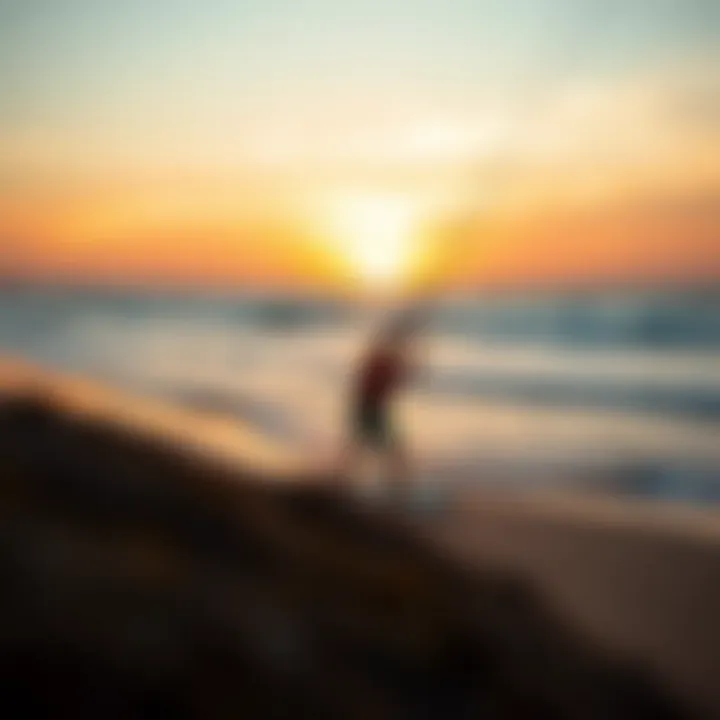
Kalpitiya is often seen as the crown jewel of kitesurfing spots in Sri Lanka. The location boasts flat water lagoons and consistent wind conditions that attract kite surfers from around the globe. The shallow waters make it particularly inviting for new kitesurfers who want to practice without the anxiety of deep water. Furthermore, the picturesque backdrop of palm trees swaying against the horizon sets the stage for an unforgettable experience.
Some say it feels like an untouched paradise; perhaps that's why it remains so popular. Yet, Kalpitiya's reputation doesn't just stem from the scenery; it’s the friendly atmosphere and vibrant local culture that enhance any kitesurfing journey here.
Accessibility
Getting to Kalpitiya is relatively straightforward. From Colombo, it is about a three-hour drive, making it a feasible day trip for many tourists. Public transport options do exist, but they can be less convenient, particularly if you are carrying equipment. Once you arrive, local services offer rentals for lockers and gear, giving you the freedom to focus solely on kitesurfing. The key characteristic is, indeed, this ease of access.
However, it’s worth noting that during the peak seasons, the influx of tourists can make the area crowded. Still, for those who experience the thrill of kitesurfing amidst fellow enthusiasts, this is often seen as part of the charm.
Safety tips
Safety in kitesurfing cannot be overstressed, especially for beginners. Kalpitiya offers its own set of guidance—encouraging new kitesurfers to take lessons or go out in pairs. The winds can shift unexpectedly, so always check the wind conditions beforehand. Furthermore, wearing a life jacket and having a buddy system can significantly mitigate risks.
A unique aspect of Kalpitiya's kitesurfing scene is the community of instructors who prioritize safety alongside fun. These tips not only enhance the enjoyment but also contribute to a safer environment overall.
Unawatuna
Spot features
Unawatuna might be known for its stunning beaches and vibrant nightlife, but it also holds its own in the kitesurfing arena. The gentle waves here cater to those looking for a leisurely kitesurfing experience. This spot is particularly appealing for individuals wanting to marry the thrill of kitesurfing with relaxation on a beautiful beach. The striking difference between this setting and Kalpitiya lies in the wave conditions—here, the surf can present gentle, rolling waves, ideal for practice.
The location's charm doesn’t stop with kitesurfing; vibrant local eateries just a stone's throw away create a lively atmosphere post-session.
Best times to visit
Unawatuna’s kitesurfing season generally runs from November to April, coinciding with the windy season. The winds during this period tend to be reliable, creating an environment where you can focus solely on honing your skills. However, if one wishes to avoid the crowds, visiting between December and February allows for a balance between good wind conditions and lesser foot traffic.
In off-peak seasons, the beach remains less crowded, allowing a quieter, more personal experience. But it’s essential to keep in mind that off-seasons can sometimes mean erratic wind conditions.
Local amenities
The overall experience in Unawatuna can greatly be bolstered by the amenities available. From cozy beach shacks serving fresh seafood to comfortable accommodations right by the beach, this area offers everything a kitesurfer might want. Local shops often have kite gear rentals, ensuring even those without equipment can fully partake.
Still, for those looking for high-end facilities or more options, the offerings might seem limited compared to larger cities.
Mannar
Spot features
Mannar might not be the first place that comes to mind for kitesurfing, but it offers a unique experience. The untouched beaches, combined with the relatively lesser-known wind patterns, make this a gem for adventurous surfers willing to explore. Its remoteness can be an appealing factor for those looking to escape the crowd, allowing for an intimate connection with nature while riding the winds.
Wind conditions
The wind conditions in Mannar can be unpredictable, but this unpredictability is part of its charm. Because of its unique geographical position, Mannar experiences varying wind patterns that can surprise seasoned surfers. If you’re adaptable, this location can reward you with exhilarating sessions that differ day by day. Notably, winds tend to pick up in the later afternoon, which allows for more flexible timing.
However, it’s wise to keep a close watch on local forecasts, as they may vary significantly within the same day. Ensuring you stay updated gives both unpredictability and excitement.
Cultural considerations
Kitesurfing in Mannar also comes with cultural elements that are worth noting. The local community is steeped in tradition, and while they’re often welcoming to visitors, it's vital to respect their customs and way of life. Understanding local norms – such as appropriate dress codes and beach etiquette – is crucial in fostering good relations and ensuring a pleasant atmosphere. Engaging positively with the community can add to the overall experience, blending sport with cultural richness.
Kitesurfing Techniques and Skills
Kitesurfing is not just about harnessing the wind; it's about mastering a variety of techniques and skills that can greatly enhance the overall experience. Whether you’re just starting out or have years under your belt, understanding the techniques relevant to this sport can make all the difference. By familiarizing yourself with the right skills, you can improve safety, navigate differing conditions, and elevate your performance on the water.
Beginner Techniques
Basic stances
At the heart of a novice kitesurfer's journey lie the basic stances. It’s the foundation upon which all further skills are built. A proper stance usually consists of having your knees bent, feet shoulder-width apart, and your body distributed equally over the board. This positioning ensures that you remain balanced, especially when the wind picks up. The standout characteristic of basic stances is their ability to absorb impact.
Properly maintaining your stance allows you to regain balance quickly after being hit by waves or gusts. The advantage is significant; it enables beginners to focus on other fundamentals without having to worry constantly about falling over. However, a disadvantage might be the initial discomfort when getting used to the positioning, as some may find it feels unnatural at first.
Controlling the kite
Control is king in kitesurfing. Learning how to manipulate the kite effectively is paramount for both safety and enjoyment. Effective kite control involves managing the speed and direction by adjusting the lines. This skill permits kitesurfers to glide smoothly across the water and avoid mishaps. The essential feature here is the ability to feel the pull of the kite and respond proportionately.
This skill is particularly beneficial; once a beginner understands how to control the kite, they can navigate different conditions with confidence. However, one of the challenges is that it requires practice to develop the necessary instinctual reactions to changes in the wind.
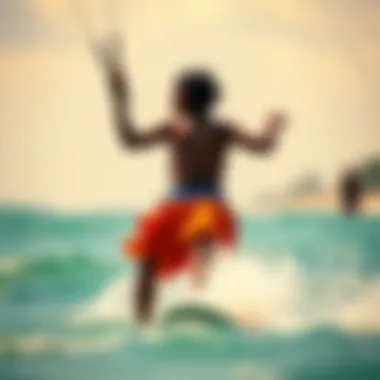
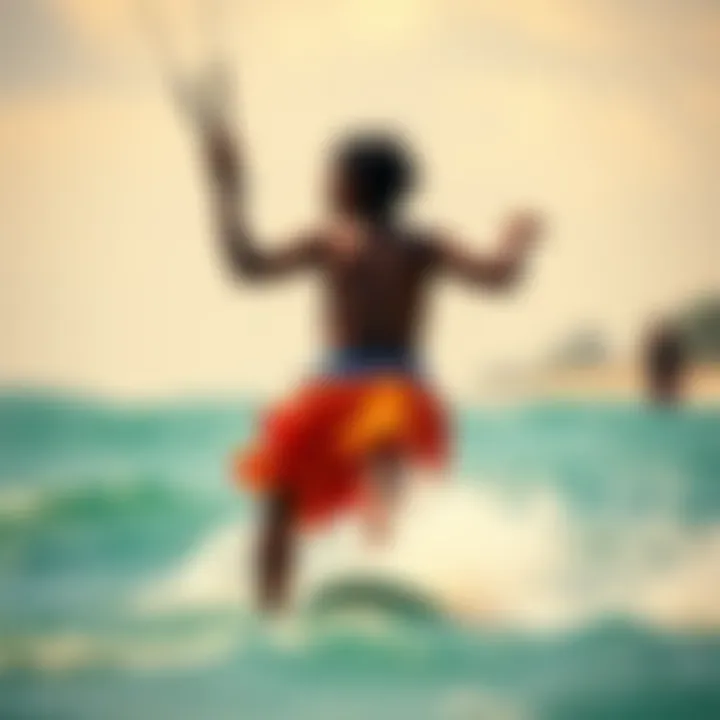
Edge control
Edge control is another vital skill for kitesurfers, particularly those starting out. It refers to the technique of using the edges of the board to increase speed or maneuver effectively. Proper edge control ensures that the board stays stable, allowing riders to carve through the water instead of skimming over the surface like a stone on a lake.
A key advantage is that enhancing edge control allows beginners to transition smoothly from one direction to another. It provides a sense of security and improves overall performance. On the flip side, mastering this technique can be tricky, as improper edge use might lead to spins or falls, frustrating the learning process.
Intermediate to Advanced Techniques
Jumping and tricks
As a kitesurfer progresses, the desire to jump or perform tricks becomes more pronounced. Jumping is not merely about getting airborne; it’s about skillfully controlling the kite and the board while in the air. This technique enhances the thrill of the sport and allows for creativity. More seasoned kitesurfers often use jumping as an expression of their style.
The unique feature of this technique lies in its versatility. There are numerous tricks one can perform while airborne. Mastering jumps also leads to improved overall kite control. However, the downside is that jumping is often seen as risky; a poorly executed jump could result in a hard landing, which can deter some less courageous kitesurfers.
Navigation skills
Being able to navigate effectively while kitesurfing cannot be emphasized enough. It involves understanding wind patterns, currents, and how to utilize them to your advantage. Strong navigation skills help riders assess their surroundings and choose the best lines while kiting. This characteristic is vital for avoiding potential hazards such as rocks or other obstacles in the water.
Effective navigation arms kitesurfers with the confidence to explore new spots while ensuring safety. Unfortunately, it can be challenging, especially for those unfamiliar with the water’s behavior, making it essential to gain experience gradually.
Emergency maneuvers
Lastly, emergency maneuvers are essential to any kitesurfing repertoire. Being prepared for unpredictable situations can save lives. Techniques such as the self-rescue or quick release of the kite are fundamental for ensuring safety in challenging conditions. This area holds supreme importance as it can mean the difference between a safe return to shore or a dangerous situation.
While mastering these techniques is beneficial, it takes time and deliberation to react appropriately in emergencies. Recognizing how to execute emergency maneuvers effectively reinforces a kitesurfer’s competence, but it requires consistent training and knowledge of one’s limits.
"Kitesurfing is a dance with the wind; learn the moves, and you'll glide with grace."
In summary, developing a diverse set of kitesurfing techniques and skills is crucial for enjoying this exhilarating sport. Beginners must focus on mastering the basics, while intermediates can explore tricks, navigation, and emergency protocols as they elevate their practice and ensure a fulfilling experience on the waters of Sri Lanka.
Equipment Essentials for Kitesurfing
Understanding the right gear is non-negotiable for anyone looking to hit the waves in Sri Lanka. Whether you're a seasoned kitesurfer or just learning the ropes, having the right equipment can make or break your experience on the water. It's not just about having the shiniest new kite or the trendiest board; it’s about knowing how each piece of gear affects your performance and safety. This section will guide you through the essentials to ensure that you are prepared, safe, and able to enjoy your time kitesurfing.
Kites Overview
Types of kites
In the kitesurfing world, kites come in various types. Generally, they can be categorized into two major classes: inflatable kites and foils. Inflatable kites tend to be more user-friendly, holding air in bladders that allow for better lift and stability. This characteristic makes them the preferred choice for most novices and intermediates, as they offer a more forgiving experience on the water.
On the flip side, we have foil kites, which are often used by advanced kitesurfers looking for higher performance in lighter winds. While these kites can be a bit tricky to handle, they give you greater speed and efficiency, ideal for those who want to take tricks or race.
Each type of kite has its own advantages and disadvantages. Inflatable kites can handle a variety of conditions and are known for their ease of use, while foil kites, although less forgiving, excel in light wind situations. Understanding these distinctions will help you navigate the gear marketplace with ease.
Choosing the right size
Selecting the correct kite size is crucial and often depends on various factors including wind conditions and your own weight. For example, lighter riders may find that a smaller kite provides better control in high winds, while heavier riders might benefit from a larger model when facing lighter conditions.
A general rule of thumb is that if you are transitioning from land to water, starting off with a kite that falls within the middle of your findings can be the safest option. In addition, knowing the location can also influence this choice. In Sri Lanka’s coastal spots like Kalpitiya or Unawatuna, where winds can shift dramatically, a variety of sizes may be needed to tackle different conditions throughout the day.
Maintenance tips
Maintaining your kite is an essential part of prolonging its life span and ensuring safety while kitesurfing. Regularly inspecting for wear and tear, such as frayed lines or punctures, can save you from potential disasters on the water. Additionally, rinsing saltwater off your equipment after each session isn’t just a good practice; it helps keep your kite and lines in optimal shape.
Also, storing your kite properly when not in use is key. Ideally, lay it flat without folding it too much to prevent creases and damage over time. Proper maintenance not only assures safety but also provides lasting value to your investment, allowing you to enjoy countless sessions on those beautiful Sri Lankan waves.
Boards and Accessories
Types of boards
When it comes to boards, they also come in a variety of shapes and styles. The most common types include twin-tip boards and directional boards. Twin-tip boards are versatile, allowing for riding in either direction, making them perfect for beginners. They enable smooth transitions and maneuvers, which is great as you begin to explore different techniques.
Directional boards, on the other hand, are more specialized and typically used for wave riding. These boards are designed to be ridden in one direction, often providing better control and speed in ocean swells. Understanding your riding style and preferred conditions can guide you in selecting the right board that suits your adventure on the waves.
Choosing bindings
Bindings are a small but significant part of your kitesurfing gear. They connect you to your board, influencing your comfort and performance level. Many kitesurfers opt for adjustable bindings to ensure a snug fit regardless of foot size or shoe thickness.
Having the right bindings can lead to enhanced control when making turns or executing tricks. However, if bindings are too loose or too tight, not only does it compromise your safety, but it can also hinder performance. So, take your time in selecting those bindings; they may seem minor, but they play a crucial role in your overall experience.

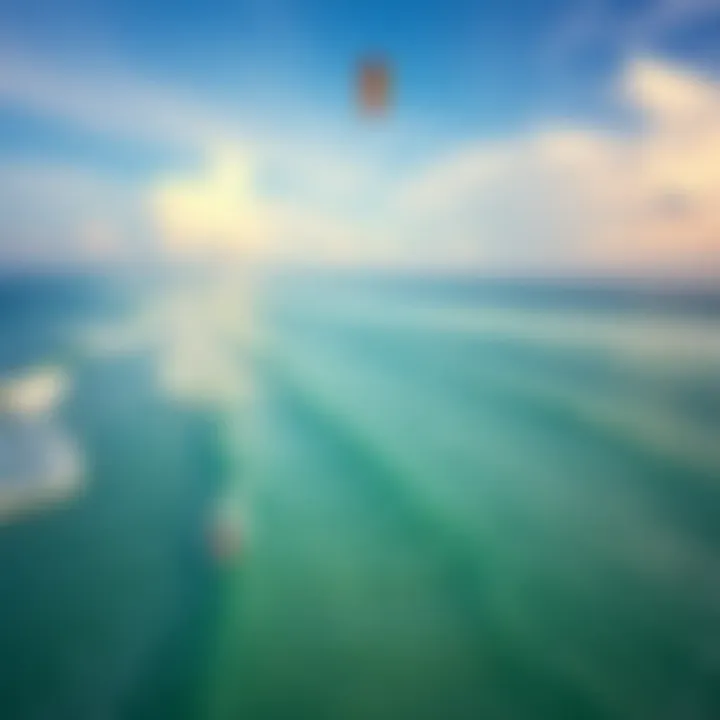
Safety gear
No kitesurfing package is complete without safety gear. A harness is fundamental, as it takes the load off your arms, allowing for longer sessions without fatigue. Also, safety leashes are essential to ensure that if you lose control of your kite, it doesn’t go far away from you.
Wearing a helmet and impact vest is also advisable, primarily when learning or riding in choppy conditions. These pieces of gear act like insurance, protecting you from injuries that could occur from falls or collisions. Although safety gear may not be glamorous, it’s invaluable and can keep your kitesurfing experience enjoyable for years to come.
Remember, the right equipment not only enhances performance but can also significantly improve your safety and enjoyment.
Cultural Aspects of Kitesurfing in Sri Lanka
Kitesurfing in Sri Lanka is not just a sport; it’s a lively tapestry woven into the fabric of local culture. This nation, known for its breathtaking beaches and idyllic landscapes, has embraced kitesurfing, making it a catalyst for community engagement and environmental awareness. By understanding the cultural narratives tied to the sport, kitesurfers can appreciate not just the thrill of riding the waves but also the profound connections they can form with the local people and their traditions.
Local Community and Involvement
In regions like Kalpitiya and Unawatuna, kitesurfing has become a bridge between locals and visitors. Many local businesses, such as cafes and accommodations, began catering specifically to kitesurfers, creating a vibrant ecosystem that benefits both parties. For instance, the emergence of surf schools and kitesurfing camps has provided jobs and training to local youths, integrating them into the world of kitesurfing. This not only empowers the community economically but fosters a deep-rooted culture of sharing both knowledge and respect for the ocean.
Local festivals often see kitesurfing exhibitions, showcasing talented homegrown athletes. Engaging with these events allows visitors to gain insight into local customs while also enjoying thrilling displays of skill on the water. Building rapport with local kitesurfers could mean sharing tips on the best conditions or even participating in communal craft days where they might repair kites together, further strengthening the bonds formed on the beach.
Sustainability and Environmental Considerations
The rise of kitesurfing in Sri Lanka also brings an urgent need to consider environmental sustainability. As more enthusiasts flock to the shores, the delicate ecosystems face potential threats from human activity. The kitesurfing community is increasingly aware of its impact on the environment, leading many to advocate for responsible practices.
Organizations, often consisting of both locals and foreigners, work tirelessly to promote beach clean-ups and marine life protection initiatives. These groups educate kitesurfers about respecting wildlife, staying clear of nesting areas, and minimizing waste. When kitesurfers engage in such measures, they create a legacy of appreciation that influences tourism positively in Sri Lanka.
"By embracing both the thrill of kitesurfing and the responsibility of protecting our oceans, we witness the true spirit of adventure intertwined with stewardship."
Notably, recent discussions in Sri Lankan sustainability forums have underscored the potential for regenerative tourism, whereby visitors are encouraged to contribute to conservation efforts during their stay. This means connecting trip experiences directly to positive environmental outcomes, forging a unique bond between kitesurfers and the pristine waters of Sri Lanka.
In summary, the cultural landscape surrounding kitesurfing in Sri Lanka reveals layers of community involvement and a growing commitment to sustainability. Visiting kitesurfers are not just participants of a sport but become part of a larger movement, enhancing their trip while contributing positively to the environment and the local populace. Engaging thoughtfully with these cultural aspects ensures that kitesurfing not only thrives but does so responsibly, preserving the stunning beauty of Sri Lanka for future generations.
Travel Considerations for Kitesurfing in Sri Lanka
When planning a kitesurfing adventure in Sri Lanka, there are several essential travel factors to consider that can make or break your experience. Understanding these aspects not only enhances your enjoyment but also ensures that you navigate the local landscape with ease. From entry requirements to where to stay and how to get around, these considerations are critical for anyone looking to catch some wind on the pristine waters of this island paradise.
Visa and Entry Requirements
Visa and entry requirements can vary depending on your nationality, so it's crucial to do your homework before landing in Sri Lanka. Most travelers will need to apply for an Electronic Travel Authorization (ETA), which can be done online. This process is fairly simple and can save you time upon arrival. The ETA typically allows for a stay of 30 days, with the option to extend, making it suitable for a kitesurfing trip that's more than just a weekend getaway.
When you're booking your travel, consider the following:
- Nationality: Different rules apply based on where you're coming from. Some countries have visa-free access, while others may face more stringent requirements.
- Duration: If you plan to kitesurf for several weeks to a month, ensure you have the necessary visa that allows for that length of stay.
For the most accurate and up-to-date information, you can refer to official government resources like Sri Lanka's Department of Immigration and Emigration.
Accommodations for Kitesurfers
Finding the right accommodations is vital. You want to stay somewhere that not only fits your budget but also gives easy access to the prime kitesurfing spots. Fortunately, Sri Lanka has a variety of options:
- Guesthouses: These are often run by locals and can offer a more intimate experience. You can find them in areas like Kalpitiya and Unawatuna. Bamboo House in Kalpitiya is a favorite among kitesurfers for its proximity to the beach.
- Resorts: If you're looking for something more luxurious, there are high-end resorts that cater specifically to water sports enthusiasts, providing amenities like gear rentals and lessons.
- Camping: For the adventurous, some kitesurfers choose to camp. Beachfront camping can offer a unique experience, giving you a front-row seat to the waves.
No matter your preference, it’s smart to book accommodations in advance, especially during peak season when kitesurfing is in full swing.
Local Transportation Options
Once you’re in Sri Lanka, getting around can present some challenges but also presents opportunities for adventure. Public transport is an option, with buses and trains linking major cities and kitesurfing spots, but may not always be the most convenient for transporting your gear. Here are some transportation methods to consider:
- Tuk-tuks: These three-wheeled vehicles are a popular and fun way to get around locally. They can take you from your accommodations to the kitesurfing spots at a reasonable price.
- Motorbike Rentals: If you're feeling bold, consider renting a scooter or motorbike. This option gives you the freedom to explore at your own pace and allows for easy transport of your kitesurfing gear.
- Car Rentals: For those who prefer a more comfortable mode of transport, renting a car can be the way to go. It allows for more flexibility, especially if you’re traveling in a group.
In summary, the travel aspects of kitesurfing in Sri Lanka should be planned carefully to ensure a fulfilling experience. Arriving prepared with knowledge of visa requirements, comfy accommodations, and local transport options will make your kitesurfing excursion a breeze. By understanding these elements, you'll be better positioned to focus on what truly matters—riding the waves and soaking in the beauty of this stunning destination.
Finale
The conclusion of this article serves a dual purpose. First, it encapsulates the various dimensions of kitesurfing in Sri Lanka, offering a comprehensive look back at the key points discussed. This spotlight on the sport highlights its growing popularity, the cultural tapestry intertwined with kitesurfing, and the unparalleled natural beauty of the locations mentioned throughout the article.
Kitesurfing in Sri Lanka is not only about riding the waves but also about connecting with a community that cherishes these amazing experiences. As more travelers flock to this island for their kitesurfing adventures, it's essential to consider the future trajectory of the sport here. The significance of sustainability cannot be overstated; safeguarding the environment for future generations must remain at the forefront of any kitesurfing expansion within the region.
Moreover, the development of local infrastructure aimed at supporting kitesurfers can bolster Sri Lanka's position as a global kitesurfing hotspot. From affordable accommodations to improved transportation options, these factors will shape the overall experience for tourists and locals alike.
"In the next few years, if the proper steps are taken to maintain the balance between tourism and environmental conservation, kitesurfing in Sri Lanka could potentially set the standard for adventure tourism worldwide."
The Future of Kitesurfing in Sri Lanka
Looking ahead, the future of kitesurfing in Sri Lanka is promising, yet it demands proactive efforts from all stakeholders involved. Ongoing investment in wind and wave research is essential to predict optimal conditions for both novice and experienced kitesurfers. Emphasis should be placed on enhancing safety protocols to ensure that everyone can enjoy the sport without undue risk.
Innovative practices regarding equipment and sustainable tourism are gradually taking root, allowing for a coexistence of exhilarating water sports and environmental stewardship. Those who choose to engage with kitesurfing in Sri Lanka must also embrace these values, understanding their responsibility not only for their own enjoyment but also for preserving the thrilling experiences for future enthusiasts.













